职称英语C级补全短文(-)
20XX职称英语新增文章综合类C级补全短文第3篇-职称英语考试.doc
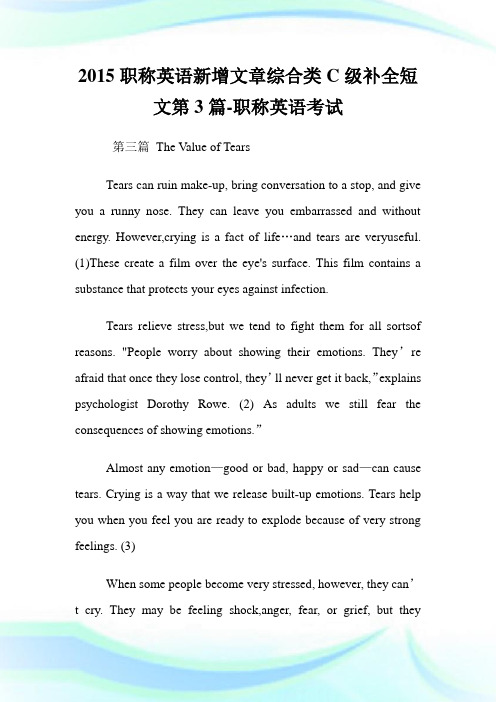
2015职称英语新增文章综合类C级补全短文第3篇-职称英语考试第三篇The Value of TearsTears can ruin make-up, bring conversation to a stop, and give you a runny nose. They can leave you embarrassed and without energy. However,crying is a fact of life…and tears are veryuseful.(1)These create a film over the eye's surface. This film contains a substance that protects your eyes against infection.Tears relieve stress,but we tend to fight them for all sortsof reasons. "People worry about showing their emotions. They’re afraid that once they lose control, they’ll never get it back,”explains psychologist Dorothy Rowe. (2) As adults we still fear the consequences of showing emotions.”Almost any emotion—good or bad, happy or sad—can cause tears. Crying is a way that we release built-up emotions. Tears help you when you feel you are ready to explode because of very strong feelings. (3)When some people become very stressed, however, they can’t cry. They may be feeling shock,anger, fear, or grief, but theyrepress the emotion. “Everyone has the need to cry,”says psychotherapist Vera Diamond. Sometimes in therapy sessions, patients participate in crying exercise (4) Diamond says it’s best to cry in safe, private places,like under the bed coversor in the car. That’s because many people get uncomfortable when others cry in front of them. In fact,they may be repressing their own need to cry.In certain situations, such as at work, tears are not appropriate.(5) “But once you are safely behind closed doors, don't just cry,”Diamond says, she suggests that you act out the whole situation again and be as noisy and angry as you like. It will help you feel better. “And,”she adds, “once your tears have released thestress, you can begin to think of logical way to deal with the problem.”Tears are a sign of our ability to feel. You should never be afraid to cry.词汇:make-up n. 化妆(品)psychotherapist n. 心理治疗师runny nose 流鼻涕infection n. 感染,传染release v. 释放built up 组合的,拼合的注释:1. …create a film over the eye’s surface :……在眼睛的表面形成一层薄膜。
职称英语理工类C类-补全短文(一)
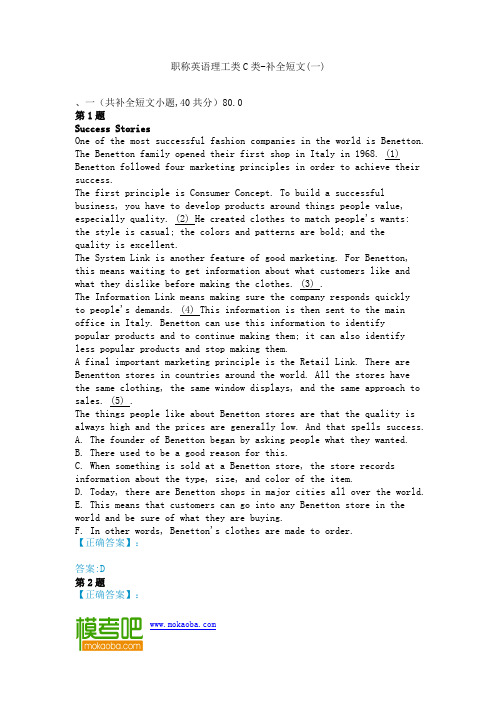
职称英语理工类C 类-补全短文(一)、一(共补全短文小题,40共分)80.0第1题Success StoriesOne of the most successful fashion companies in the world is Benetton. The Benetton family opened their first shop in Italy in 1968. (1) Benetton followed four marketing principles in order to achieve their success.The first principle is Consumer Concept. To build a successful business, you have to develop products around things people value, especially quality. (2) He created clothes to match people's wants: the style is casual; the colors and patterns are bold; and the quality is excellent.The System Link is another feature of good marketing. For Benetton, this means waiting to get information about what customers like and what they dislike before making the clothes. (3) .The Information Link means making sure the company responds quickly to people's demands. (4) This information is then sent to the main office in Italy. Benetton can use this information to identify popular products and to continue making them; it can also identify less popular products and stop making them.A final important marketing principle is the Retail Link. There are Benentton stores in countries around the world. All the stores have the same clothing, the same window displays, and the same approach to sales. (5) .The things people like about Benetton stores are that the quality is always high and the prices are generally low. And that spells success.A. The founder of Benetton began by asking people what they wanted.B. There used to be a good reason for this.C. When something is sold at a Benetton store, the store records information about the type, size, and color of the item.D. Today, there are Benetton shops in major cities all over the world.E. This means that customers can go into any Benetton store in the world and be sure of what they are buying.F. In other words, Benetton's clothes are made to order.【正确答案】:答案:D第2题【正确答案】:答案:A第3题【正确答案】:答案:F第4题【正确答案】:答案:C第5题【正确答案】:答案:E第6题Caribbean IslandsWhat would you see if you took a cruise to the Caribbean Islands? Palm trees and coconuts (椰子)? White beaches and clear, blue ocean? Colorful corals (珊瑚) and even more colorful fishes and birds? You bet. There are thousands of islands in the Caribbean Sea. They are famous for their warm, tropical climate and great natural beauty. The Caribbean Islands form a chain that separates the Caribbean Sea from the rest of the Atlantic Ocean. Some of the islands were formed by the eruption (爆发) of ancient volcanoes (火山). (1) . The Caribbean Islands are known by several names. (2) The explorer Christopher Columbus called the islands the Indies in 1492 because he thought he was near the coast of India. Later, Spain and France called the islands the Antilles. There are four large islands in the Caribbean Sea. 3) These fourislands are often called the Greater Antilles. Together, they account for about 90 percent of the land area of the Caribbean Islands. The rest of the Caribbean Islands are much smaller. Some of these islands are no more than tiny slivers (小片) of exposed coral. You can see why pirates (海盗) such as the famous Blackbeard sailed these waters. (4) .The weather of the Caribbean Sea is almost always warm and sunny. Sandy beaches line the coasts of many islands. This is why millions of tourists visit the islands each year. (5) .A. But life on the Caribbean Islands is not always painful.B. The earliest name used by Europeans is the Indies, later changed to the West Indies;C. Others are low-lying coral islands that gradually rose from the ocean.。
职称英语理工类C类-补全短文专项突破

职称英语理工类C类-补全短文专项突破(总分:100.00,做题时间:90分钟)一、补全短文(总题数:4,分数:100.00)Farmers' MarketsCharlotte Hollins knows she faces a battle. The 23-year-old British farmer and her 21-year-old brother Ben are fighting to save the farm from developers that their father worked on since he was 14. (1)"You don't often get a day off. Supermarkets put a lot of pressure on farmers to keep prices down. With fewer people working on farms it can be isolating," she said. "There is a high rate of suicide and farming will never make you rich! "Oliver Robinson, 25, grew up on a farm in Yorkshire. (2) "I'm sure dad hoped I'd stay," he said. "I guess it's a nice, straightforward life, but it doesn't appeal. For young, ambitious people, farm life would be a hard world. " For Robinson, farming doesn't offer much "in terms of money or lifestyle. " Hollins agrees that economics stops people from pursuing farming rewards: "providing for a vital human need, while working outdoors with nature. "Farming is a big political issue in the UK. (3) The 2001 foot and mouth crisis closed thousands of farms, stopped meat exports, and raised public consciousness of troubles in UK farming. Jamie Oliver's 2005 campaign to get children to eat healthily also highlighted the issue. This national concern spells (带来) hope for farmers competing with powerful supermarkets. (4) "I started going to Farmers' Markets in direct defiance (蔑视) of the big supermarkets. (5) It's terrible," said Londoner Michael Samson.A.But he never considered staying on his father and grandfather's land.B.While most people buy food from the big supermarkets, hundreds of independent Farmers' Markets are becoming popular.C.While confident they will succeed, she lists farming's many challenges.D.Young people prefer to live in cities.E.I seriously objected to the super-sizing of everything—what exactly DO they put on our apples to make them so big and red?F."Buy British" campaigns urge (鼓励) consumers not to buy cheaper imported foods.(分数:25.00)填空项1:__________________ (正确答案:C)解析:填空项1:__________________ (正确答案:A)解析:填空项1:__________________ (正确答案:F)解析:填空项1:__________________ (正确答案:B)解析:填空项1:__________________ (正确答案:E)解析:The RoadrunnerThe roadrunner (走雀) lives in the desert zone of the southwestern United States and northern Mexico. (1) People gave it its name because they usually see it running across a road, but of course, it spends more time among the plants of the desert than it does on roads.The roadrunner is quite a large bird—about 45 centimeters long and 25 centimeters high. (2) It holds its head straight out in front and its tail sticks straight out in back. It takes long steps and can run 30 kilometers an hour.It eats an amazing variety of food. Although it eats plants once in a while, it is mostly a meat eater. Most of its diet is insects, but it also catches birds, mice, and other small animals. It is even brave enough to catch snakes and black widow spiders (蛛).(3) When he finds one, he gives her presents—a snake to eat or a tiny branch of a tree to use in building a nest. Then they build their nest, the female lays eggs, and they raise their young.(4) One couple in Arizona feeds a pair of roadrunners that come once at a time every day and makea noise outside the window. If someone doesn't give the bird a piece of hamburger immediately, the bird knocks on the window with its beak (喙). Roadrunners are not shy.(5) They will stand on a chair or table and watch television, and they seem really interested in what is happening on the program.A.Roadrunners can also become friendly with people.B.People laugh when it runs because it looks so funny.C.It is a bird, but it can only fly about as much as a chicken can.D.In early spring, the bird doesn't eat anything.E.Another couple feeds a pair of roadrunners that go right into the house.F.In the spring, a male roadrunner begins looking for a female as a mate.(分数:25.00)填空项1:__________________ (正确答案:C)解析:填空项1:__________________ (正确答案:B)解析:填空项1:__________________ (正确答案:F)解析:填空项1:__________________ (正确答案:A)解析:填空项1:__________________ (正确答案:E)解析:Caribbean IslandsWhat would you see if you took a cruise to the Caribbean Islands? Palm trees and coconuts (椰子)? White beaches and clear, blue ocean? Colorful corals (珊瑚) and even more colorful fishes and birds?You bet. There are thousands of islands in the Caribbean Sea. They are famous for their warm, tropical climate and great natural beauty.The Caribbean Islands form a chain that separates the Caribbean Sea from the rest of the Atlantic Ocean. (1) Many of the islands were formed by the eruption (爆发) of ancient volcanoes (火山). Others are low-lying coral islands that gradually rose from the ocean.The Caribbean Islands are known by several names. (2) The explorer Christopher Columbus called the islands the Indies in 1492 because he thought he was near the coast of India. Later, Spain and France called the islands the Antilles.There are four large islands in the Caribbean Sea. (3) These four islands are often called the Greater Antilles. Together, they account for about 90 per cent of the land area of the Caribbean Islands.The rest of the Caribbean Islands are much smaller. (4) You can see why pirates such as the famous Blackbeard sailed these waters. There are countless small islands to bury treasure or hide on.The weather of the Caribbean Sea is almost always warm and sunny. Sandy beaches line the coasts of many islands. (5) Many tourists arrive on cruise ships.A.But life on the Caribbean Islands is not always paradise.B.The earliest name used by Europeans is the Indies, later changed to the West Indies. C.They're like a long necklace that stretches between North and South America.D.They are Cuba, Puerto Rico, Jamaica, and Hispaniola.E.This is why millions of tourists visit the islands each year.F.Some of these islands are no more than tiny slivers (小片) of exposed coral.(分数:25.00)填空项1:__________________ (正确答案:C)解析:填空项1:__________________ (正确答案:B)解析:填空项1:__________________ (正确答案:D)解析:填空项1:__________________ (正确答案:F)解析:填空项1:__________________ (正确答案:E)解析:The Joy of Living AloneMore and more Americans are living alone. Some live alone because of divorce or the death of a partner. (1) According to a recent U.S. census (人口普查), 25 per cent of all households in the U.S. are made up of just one person. This is a dramatic change from the extended families of just a couple of generations ago.The typical person living alone is neither old nor lonely. (2) The majority of these people have chosen to live alone. They are responding to decreasing social pressure to get married and have a family.It's now socially acceptable, even fashionable, to live alone. As people get better jobs and become financially independent, it becomes possible for them to maintain a one-person household. (3) However, people who do get married are marrying at a later age and divorcing more often.The number one reason given by most people for living alone is that they simply enjoy doing what they want when they want to do it. "Living alone is a luxury," says Nina Hagiwara, 38. "Once you do it, you can't ever go back to living with others. " David C'Debaca, 46, agrees. (4) Children think that being grown up means being able to do exactly as they please. (5) The chance to discover whether that freedom is as wonderful as it sounds is a chance more and more Americans are taking.A.There's more pressure to get married nowadays.B.The growing number of women with good jobs has done much to increase the number of people living alone.C.However, even more people are living alone because they have chosen to.D.It seems that many grown-ups today are realizing that childhood dream.E.In fact, a quarter of the 23 million single people in the U.S. are under the age of 35. F.He says, "I like being by myself. /(分数:25.00)填空项1:__________________ (正确答案:C)解析:填空项1:__________________ (正确答案:E)解析:填空项1:__________________ (正确答案:B)解析:填空项1:__________________ (正确答案:F)解析:填空项1:__________________ (正确答案:D)解析:。
职称英语 c级 第5部分:补全短文
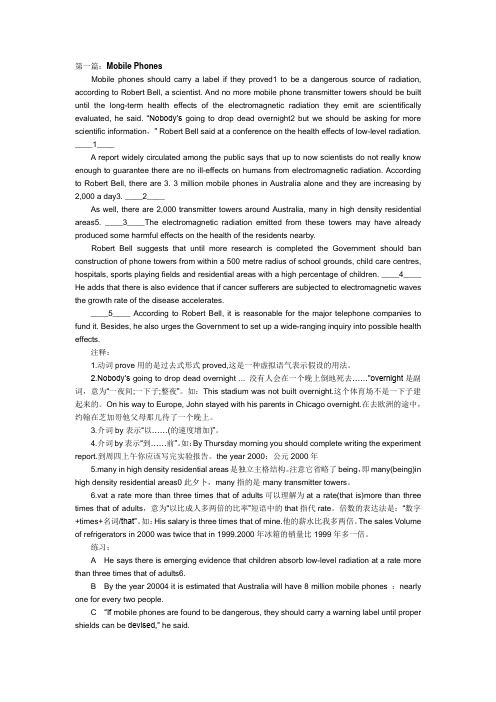
第一篇:Mobile PhonesMobile phones should carry a label if they proved1 to be a dangerous source of radiation, according to Robert Bell, a scientist. And no more mobile phone transmitter towers should be built until the long-term health effects of the electromagnetic radiation they emit are scientifically evaluated, he said. “Nobody’s going to drop dead overnight2 but we should be asking for more scientific information,” Robert Bell said at a conference on the health effects of low-level radiation. ____1____A report widely circulated among the public says that up to now scientists do not really know enough to guarantee there are no ill-effects on humans from electromagnetic radiation. According to Robert Bell, there are 3. 3 million mobile phones in Australia alone and they are increasing by 2,000 a day3. ____2____As well, there are 2,000 transmitter towers around Australia, many in high density residential areas5. ____3____The electromagnetic radiation emitted from these towers may have already produced some harmful effects on the health of the residents nearby.Robert Bell suggests that until more research is completed the Government should ban construction of phone towers from within a 500 metre radius of school grounds, child care centres, hospitals, sports playing fields and residential areas with a high percentage of children. ____4____ He adds that there is also evidence that if cancer sufferers are subjected to electromagnetic waves the growth rate of the disease accelerates.____5____ According to Robert Bell, it is reasonable for the major telephone companies to fund it. Besides, he also urges the Government to set up a wide-ranging inquiry into possible health effects.注释:1.动词prove用的是过去式形式proved,这是一种虚拟语气表示假设的用法。
2020年职称英语理工类C级补全短文练习题(1)
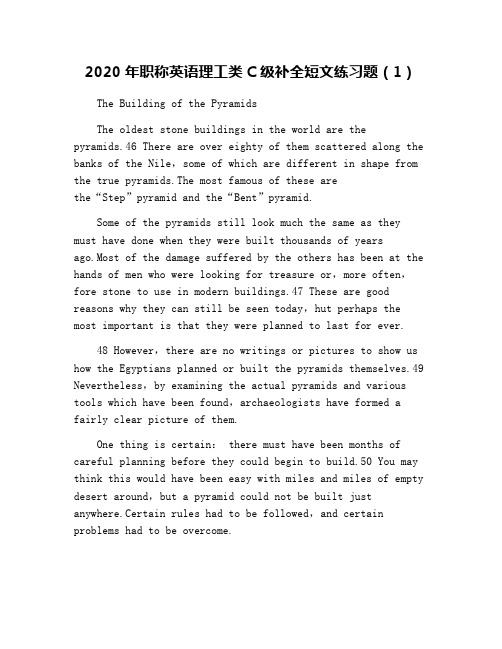
2020年职称英语理工类C级补全短文练习题(1)The Building of the PyramidsThe oldest stone buildings in the world are the pyramids.46 There are over eighty of them scattered along the banks of the Nile,some of which are different in shape from the true pyramids.The most famous of these arethe“Step”pyramid and the“Bent”pyramid.Some of the pyramids still look much the same as they must have done when they were built thousands of yearsago.Most of the damage suffered by the others has been at the hands of men who were looking for treasure or,more often,fore stone to use in modern buildings.47 These are good reasons why they can still be seen today,hut perhaps the most important is that they were planned to last for ever.48 However,there are no writings or pictures to show us how the Egyptians planned or built the pyramids themselves.49 Nevertheless,by examining the actual pyramids and various tools which have been found,archaeologists have formed a fairly clear picture of them.One thing is certain: there must have been months of careful planning before they could begin to build.50 You may think this would have been easy with miles and miles of empty desert around,but a pyramid could not be built just anywhere.Certain rules had to be followed,and certain problems had to be overcome.A.The dry climate of Egypt has helped to preserve the pyramids,and their very shape have made them less likely to fall into ruin.B.It is practically certain that plans were made for the building of the pyramids because the plans of other large works have fortunately been preserved.C.The first thing they had to do was to choose a suitable place.D.Consequently,we are only able to guess at the methods used.E.Many people were killed while building the pyramids.F.They have stood for nearly 5,000 years,and it seems likely that they will continue to stand for thousands of years yet.参考答案:46.F,第一句话说金字塔是世界上最古老的石头建筑,F说:“它们已经屹立了将近五千年并且似乎会继续存有数千年”,以实际数字说明了第一句,所以应选F.47.A,A说:“埃及干燥的气候有助于保持金字塔,金字塔自身的形状也使之不容易毁坏。
职称英语《综合C》补全短文真题及答案
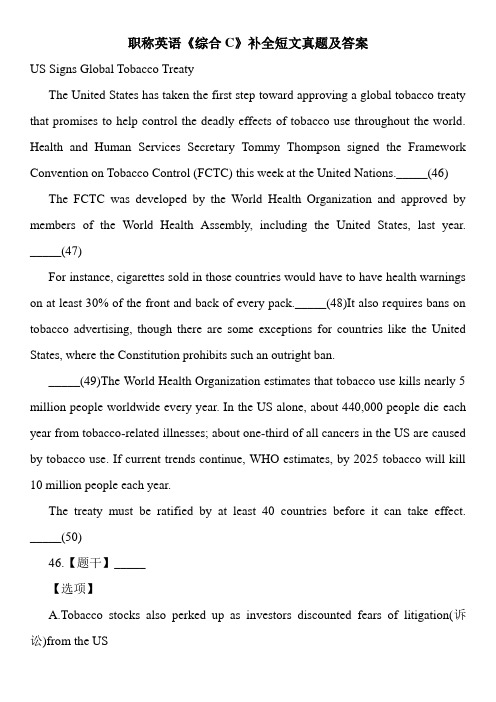
职称英语《综合C》补全短文真题及答案US Signs Global Tobacco TreatyThe United States has taken the first step toward approving a global tobacco treaty that promises to help control the deadly effects of tobacco use throughout the world. Health and Human Services Secretary Tommy Thompson signed the Framework Convention on Tobacco Control (FCTC) this week at the United Nations._____(46) The FCTC was developed by the World Health Organization and approved by members of the World Health Assembly, including the United States, last year. _____(47)For instance, cigarettes sold in those countries would have to have health warnings on at least 30% of the front and back of every pack._____(48)It also requires bans on tobacco advertising, though there are some exceptions for countries like the United States, where the Constitution prohibits such an outright ban._____(49)The World Health Organization estimates that tobacco use kills nearly 5 million people worldwide every year. In the US alone, about 440,000 people die each year from tobacco-related illnesses; about one-third of all cancers in the US are caused by tobacco use. If current trends continue, WHO estimates, by 2025 tobacco will kill 10 million people each year.The treaty must be ratified by at least 40 countries before it can take effect. _____(50)46.【题干】_____【选项】A.Tobacco stocks also perked up as investors discounted fears of litigation(诉讼)from the USB.So far, 109 countries have signed it, and 12 have ratified it.C.The impact of the treaty could be huge.D.Countries that ratify(批准)it would be required to enact strict tobacco control policies.E.The treaty calls for higher tobacco taxes, restrictions on smoking in public places, and more promotion of tobacco prevention and cessation programs.F.The Senate must still approve the treaty before the US can implement its provisions.【答案】F【解析】47.【题干】_____【选项】A.Tobacco stocks also perked up as investors discounted fears of litigation(诉讼)from the USB.So far, 109 countries have signed it, and 12 have ratified it.C.The impact of the treaty could be huge.D.Countries that ratify(批准)it would be required to enact strict tobacco control policies.E.The treaty calls for higher tobacco taxes, restrictions on smoking in public places, and more promotion of tobacco prevention and cessation programs.F.The Senate must still approve the treaty before the US can implement its provisions.【答案】D【解析】48.【题干】_____【选项】A.Tobacco stocks also perked up as investors discounted fears of litigation(诉讼)from the USB.So far, 109 countries have signed it, and 12 have ratified it.C.The impact of the treaty could be huge.D.Countries that ratify(批准)it would be required to enact strict tobacco control policies.E.The treaty calls for higher tobacco taxes, restrictions on smoking in public places, and more promotion of tobacco prevention and cessation programs.F.The Senate must still approve the treaty before the US can implement its provisions.【答案】E【解析】49.【题干】_____【选项】A.Tobacco stocks also perked up as investors discounted fears of litigation(诉讼)from the USB.So far, 109 countries have signed it, and 12 have ratified it.C.The impact of the treaty could be huge.D.Countries that ratify(批准)it would be required to enact strict tobacco control policies.E.The treaty calls for higher tobacco taxes, restrictions on smoking in public places, and more promotion of tobacco prevention and cessation programs.F.The Senate must still approve the treaty before the US can implement its provisions.【答案】C【解析】50.【题干】_____【选项】A.Tobacco stocks also perked up as investors discounted fears of litigation(诉讼)from the USB.So far, 109 countries have signed it, and 12 have ratified it.C.The impact of the treaty could be huge.D.Countries that ratify(批准)it would be required to enact strict tobacco control policies.E.The treaty calls for higher tobacco taxes, restrictions on smoking in public places, and more promotion of tobacco prevention and cessation programs.F.The Senate must still approve the treaty before the US can implement its provisions.【答案】B。
XX职称英语《综合C》补全短文专项练习

XX职称英语《综合C》补全短文专项练习短文就是篇幅短小的文章。
短文就是就可能的浓缩精华考点,以检测考生水平。
下面是的xx《综合C》补全短文专项练习,希望对大家有用,更多信息请浏览!All of us have felt pain. We have cut ourselves. We have been burned. Or we have had headaches. Some of us suffer pain rarely pain rarely. (46)Pain can take plete control of our body and mind, making it impossible to move and even to think. Yet we need pain. Without it, we would not know if we have hurt ourselves. It is our body's warning system. (47)Pain is the most mon reason we go to a doctor. It is the most mon reason we take medicines.Until recently, however, most doctors knew of only a few drugs that stopped some pains. (48)But new knowledge about the process of pain is helping them to control pain better.Scientists have learned that the sense of pain is made up of both chemical and electrical signals.(49) Scientists also have learned that the nervous system sends two different kinds of pain messages to the brain: one very fast, the other slow.The first message is the warning signal. It moves at a speed of 30 meters a second. In less than a second, the brain understands that part of the body is hurt and howbadly it is injured. (50)It tells us not to use theinjured part until it heals.A. And others have painful attacks all the time.B. These signals travel from nerve cells in the injured area, up the spinal cord ( 脊髓 ) to the brain, and back down again.C. It tells us that we are injured and should do something about it.D. They knew little about the process of pain itself.E. The other message moves at a speed of only one meter a second,F. And they send the second, slower message of pain to t.he brain.46.A。
职称英语综合类C级真题(补全短文)

职称英语综合类C级真题(补全短文)第5部分:补全短文( 第46~50题, 每题2分,共10分)下面的短文有5处空白,短文后有6个句子,其中5个取自短文,请根据短文内容将其分别放回原有位置,以恢复文章原貌。
Explore JordanWadi Rum is the name given to a valet cut into the sandstone and hard rock in northwest Jordan. (46)_____ The name Rum most likely comes from an Aramaic word meaning “high” or “elevated”. The area around Wadi Rum is now also one of Jordan’s most important tourist destination, and attracts an increasing number of foreign tourists, particularly trekkers (越野者), but also for camel safaris (旅行) or simply day-trippers from Aqaba or Petra. In contrast, there are almost no local or Arab tourists, through nearby Disi attracts young people from Amman at the weekends.Popular activities in the desert environmental includes camping under the stars, riding Arab horse, and rock-climbing amongst the massive rock formations. Jebal Rum( jebal means ”mountain” ) is 1574 meters above sea level. (47)______ But Jordan is not simply a desert environmental-it also contains the area which is the lowest point to the face of the Earth----the incredible Dead Sea, popular with tourists for swimming. (48)_____ Once the waters reach the Dead Sea they are landlocked and have nowhere to go, so whey evaporate, leaving behind a dese, rich cocktail(混合的) of salts and minerals that supply industry, agriculture and medicine with some of its finest products. Once again, tourists benefit and can participate in water spa treatments and water therapies.The Dead Sea is located in the syro-African Rift, a 4000-mile fault line in the Earth’s crust. The lowest point of dry land on Earth is the shoreline of the Dead Sea at1.300 feel below sea level. Because the lake is at the lowest point, this means that water does not drain from it.(49)____ Figures for the Dead Sea’s salinity(盐度)today range from 25% to 35%.But the greatest tourist attraction is the incredible city of Petra. (50)_____ It is a vast unique city, carved into the sheer rock face by the Nabataeans, an industrious Arab people who settled here more than 2, 000 years ago, turning it into an important junction for the silk, spice and other trade routes that linked China India and southern Arabia with Egypt, Syria, Greece and Rome. Today, visitors can marvel at the architecture and explore life as it was thousands of years ago.A. It is the largest wadi( riverbed) in Jordan.B. It is the second highest peak in Jordan, rising directly above the Rum valley opposite Jebal Um Ishrin.C. This vast stretch of water receives a number of incoming river, including the River Jordan.D. The area has been used as a background setting in a number of films.E. Every day seven million tons of water evaporate from the lake, but the minerals remain causing the salt content to increase.F. It is without doubt Jordan’s most valuable treasure.。
职称英语综合类C级补全短文提高练习汇总
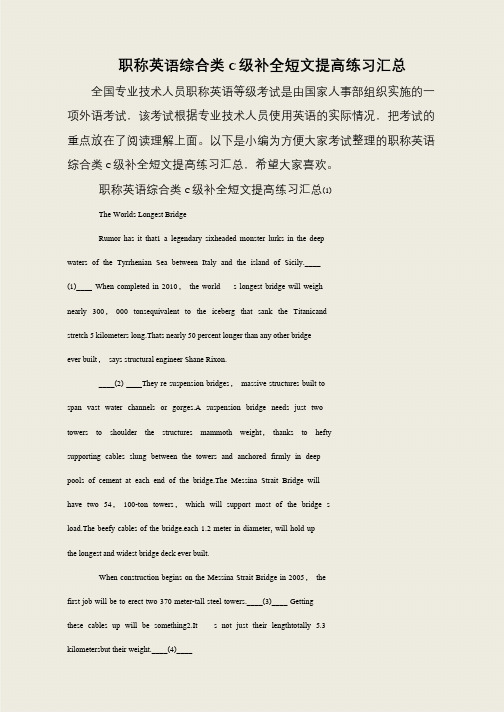
职称英语综合类C 级补全短文提高练习汇总全国专业技术人员职称英语等级考试是由国家人事部组织实施的一项外语考试,该考试根据专业技术人员使用英语的实际情况,把考试的重点放在了阅读理解上面。
以下是小编为方便大家考试整理的职称英语综合类C 级补全短文提高练习汇总,希望大家喜欢。
职称英语综合类C 级补全短文提高练习汇总(1)The Worlds Longest BridgeRumor has it that1 a legendary sixheaded monster lurks in the deepwaters of the Tyrrhenian Sea between Italy and the island of Sicily.____(1)____ When completed in 2010,the world s longest bridge will weighnearly 300,000 tonsequivalent to the iceberg that sank the Titanicandstretch 5 kilometers long.Thats nearly 50 percent longer than any other bridgeever built,says structural engineer Shane Rixon.____(2) ____They re suspension bridges,massive structures built tospan vast water channels or gorges.A suspension bridge needs just twotowers to shoulder the structures mammoth weight,thanks to heftysupporting cables slung between the towers and anchored firmly in deeppools of cement at each end of the bridge.The Messina Strait Bridge willhave two 54,100-ton towers,which will support most of the bridge sload.The beefy cables of the bridge.each 1.2 meter in diameter, will hold upthe longest and widest bridge deck ever built.When construction begins on the Messina Strait Bridge in 2005,thefirst job will be to erect two 370 meter-tall steel towers.____(3)____ Gettingthese cables up will be something2.It s not just their lengthtotally 5.3kilometersbut their weight.____(4)____。
职称英语综合类C级备考补全短文练习题
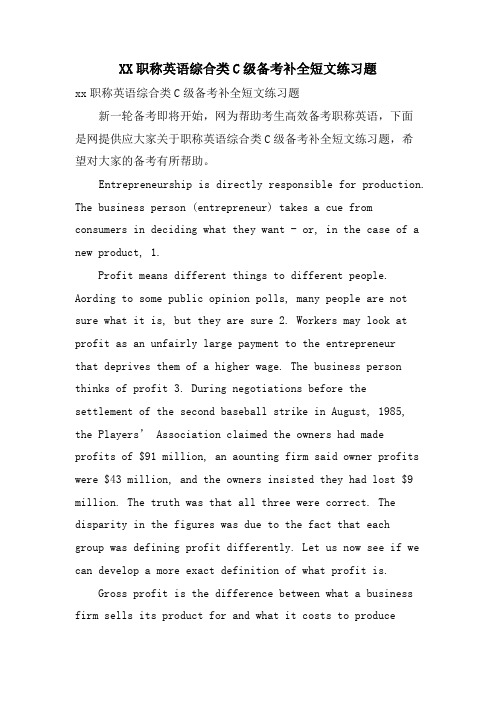
XX职称英语综合类C级备考补全短文练习题xx职称英语综合类C级备考补全短文练习题新一轮备考即将开始,网为帮助考生高效备考职称英语,下面是网提供应大家关于职称英语综合类C级备考补全短文练习题,希望对大家的备考有所帮助。
Entrepreneurship is directly responsible for production. The business person (entrepreneur) takes a cue from consumers in deciding what they want - or, in the case of a new product, 1.Profit means different things to different people. Aording to some public opinion polls, many people are not sure what it is, but they are sure 2. Workers may look at profit as an unfairly large payment to the entrepreneurthat deprives them of a higher wage. The business person thinks of profit 3. During negotiations before the settlement of the second baseball strike in August, 1985, the Players’ Association claimed the owners had madeprofits of $91 million, an aounting firm said owner profits were $43 million, and the owners insisted they had lost $9 million. The truth was that all three were correct. The disparity in the figures was due to the fact that eachgroup was defining profit differently. Let us now see if we can develop a more exact definition of what profit is.Gross profit is the difference between what a business firm sells its product for and what it costs to producethat product. The merchant buys $200,000 worth of merchandise during the year and sells it for $270,000. His gross profit is $70,000. The percentage difference between his cost and the selling price is 35 percent, and he calls this markup.Net profit is 4--rent, wages, and interest-and setting aside money to allow for the loss due to depreciation (wearing out) of capital. Our merchant has to subtract from his gross profit his payments for rent ($6,000), wages ($20,000), interest on money borrowed ($1,000), repairs and upkeep ($1,000), taxes ($1,000), electricity and other expenses $1,000. Expenses for operating the business e to $30,000. Gross profit is $70,000, and profit is $40,000.Economists have a narrower definition of what constitutes profit. They are concerned with payment for all the resources that have gone into production, 5, like those listed above, or from inside the business.Exercise:A what profit really meansB it is too large and represents too much of the consumer’s dollarC whether they e from outside the businessD as the difference between total revenue and total costE what the business person has left after paying expensesF what they might wantThe main problem in discussing American popular culture is also one of its main characteristics:it won’t stay American.No matter what it is,whether it is films,food and fashion,music,casual sports or slang,it’s soon at home elsewhere in the world1. There are several theories why American popular culture has had this appeal.One theory is that it has been“advertised”and marketed through American films,popular music,and more recently,television. 1 They are,after all,in petition with those produced by other countries.Another theory,probably a more mon one,is that American popular culture is internationally associated with something cal led“the spirit of America.” 2The final theory is less plex:American popular culture is popular because a lot of people in the world like it.Regardless of why it spreads,2 American popular culture is usually quite rapidly adopted and then adapted in many other countries 3 “Happy Birthday to You,”for instance,is such an everyday song that its source,its American copyright,so to speak,is not remembered.Black leather jackets worn by many heroes in American movies could befound,a generation 1ater,on all those young men who wanted to make this manly-look their own.Two areas where this continuing process is most clearly seen are clothing and music.Some people can still remember a time when T-shirts,jogging clothes,tennis shoes,denim jackets,and blue jeans were not mon daily wear everywhere.Only twenty years ago,it was possible to spot an American in Paris by his or her clothes.No longer so:those bright colors, checkered jackets and trousers,hats and socks which were once made fun of in cartoons are back again in Paris as the latest fashion.3 4The situation with American popular music is more plex because in the beginning.when it was still clearly American,it was often strongly resisted.Jazz was once thought to be a great danger to youth and their morals,and was actually outlawed in several countries.Today, whilestill showing its rather American roots,it has bee so well established.Rock‘n’roll and all its variations,country & western music,4 all have more or less similarhistories.They were first resisted,often in America as well,as being“low-class,”and then as“a danger to our nation’s youth.” 5 And then the music became aepted and was extended and developed,and exported back to the US.词汇:appeal n.吸引力 copyright n.版权spot v.认出 market v.推上市场,销售denim n.粗棉布注释:1.No matter what it is,whether it is films,food and fashion,music,casual sports or slang,it’s soon at home elsewhere in the world.:不管是哪一种形式的'通俗文化,不管是电影还是食物和时装,是音乐还是休闲运动,或者是俚语,它都能很快在世界上别的地方安家。
职称英语综合C补全短文指导训练
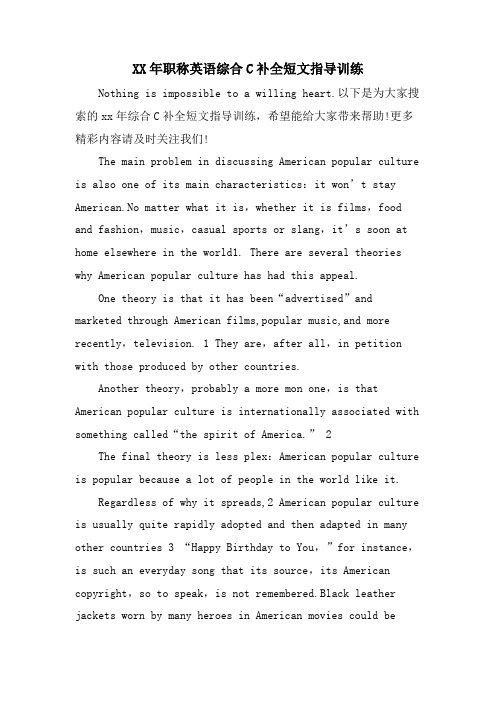
XX年职称英语综合C补全短文指导训练Nothing is impossible to a willing heart.以下是为大家搜索的xx年综合C补全短文指导训练,希望能给大家带来帮助!更多精彩内容请及时关注我们!The main problem in discussing American popular culture is also one of its main characteristics:it won’t stay American.No matter what it is,whether it is films,food and fashion,music,casual sports or slang,it’s soon at home elsewhere in the world1. There are several theories why American popular culture has had this appeal.One theory is that it has been“advertised”and marketed through American films,popular music,and more recently,television. 1 They are,after all,in petition with those produced by other countries.Another theory,probably a more mon one,is that American popular culture is internationally associated with something called“the spirit of America.” 2The final theory is less plex:American popular culture is popular because a lot of people in the world like it.Regardless of why it spreads,2 American popular culture is usually quite rapidly adopted and then adapted in many other countries 3 “Happy Birthday to You,”for instance,is such an everyday song that its source,its American copyright,so to speak,is not remembered.Black leather jackets worn by many heroes in American movies could befound,a generation 1ater,on all those young men who wanted to make this manly-look their own.Two areas where this continuing process is most clearly seen are clothing and music.Some people can still remember a time when T-shirts,jogging clothes,tennis shoes,denim jackets,and blue jeans were not mon daily wear everywhere.Only twenty years ago,it was possible to spot an American in Paris by his or her clothes.No longer so:those bright colors, checkered jackets and trousers,hats and socks which were once made fun of in cartoons are back again in Paris as the latest fashion.3 4The situation with American popular music is more plex because in the beginning.when it was still clearly American,it was often strongly resisted.Jazz was once thought to be a great danger to youth and their morals,and was actually outlawed in several countries.Today, whilestill showing its rather American roots,it has bee so well established.Rock‘n’roll and all its variations,country & western music,4 all have more or less similarhistories.They were first resisted,often in America as well,as being“low-class,”and then as“a danger to our nation’s youth.” 5 And then the music became aepted and was extended and developed,and exported back to the US.appeal n.吸引力 copyright n.版权spot v.认出 market v.推上市场,销售denim n.粗棉布1.No matter what it is,whether it is films,food and fashion,music,casual sports or slang,it’s soon at home elsewhere in the world.:不管是哪一种形式的通俗文化,不管是电影还是食物和时装,是音乐还是休闲运动,或者是俚语,它都能很快在世界上别的地方安家。
职称英语试题《综合C》补全短文练习题
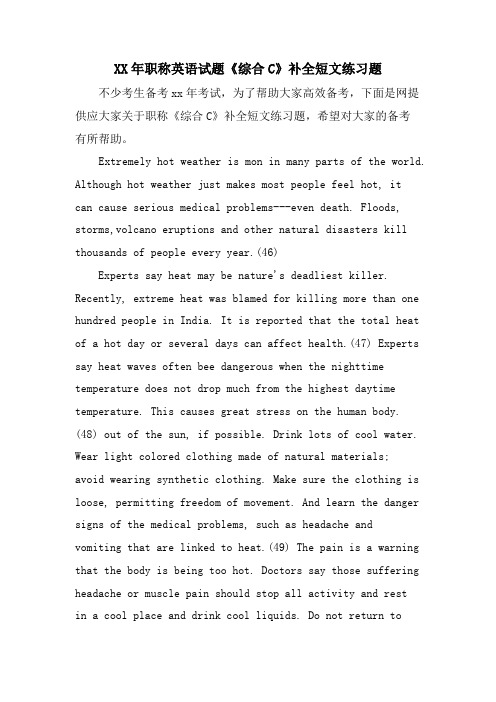
XX年职称英语试题《综合C》补全短文练习题不少考生备考xx年考试,为了帮助大家高效备考,下面是网提供应大家关于职称《综合C》补全短文练习题,希望对大家的备考有所帮助。
Extremely hot weather is mon in many parts of the world. Although hot weather just makes most people feel hot, itcan cause serious medical problems---even death. Floods, storms,volcano eruptions and other natural disasters kill thousands of people every year.(46)Experts say heat may be nature's deadliest killer. Recently, extreme heat was blamed for killing more than one hundred people in India. It is reported that the total heat of a hot day or several days can affect health.(47) Experts say heat waves often bee dangerous when the nighttime temperature does not drop much from the highest daytime temperature. This causes great stress on the human body. (48) out of the sun, if possible. Drink lots of cool water. Wear light colored clothing made of natural materials;avoid wearing synthetic clothing. Make sure the clothing is loose, permitting freedom of movement. And learn the danger signs of the medical problems, such as headache andvomiting that are linked to heat.(49) The pain is a warning that the body is being too hot. Doctors say those suffering headache or muscle pain should stop all activity and restin a cool place and drink cool liquids. Do not return tophysical activity for a few hours because more serious conditions could develop.Doctors say some people face an increased danger from heat stress. (50) Hot weather also increases dangers for people who must take medicine for high blood pressure, poor blood flow, nervousness or depression.A. Such persons have a weak or damaged heart, high blood pressure, or other problems of the blood system.B. Several of these conditions are present at the same time.C. Most people suffer only muscle pain as a result of heat stress.D. Several hot days are considered a heat wave.E. So does extreme heat.F. Doctors say people can do many things to protect themselves from the dangers of extreme heat.46.E。
职称英语综合类C级补全短文提高练习(2)
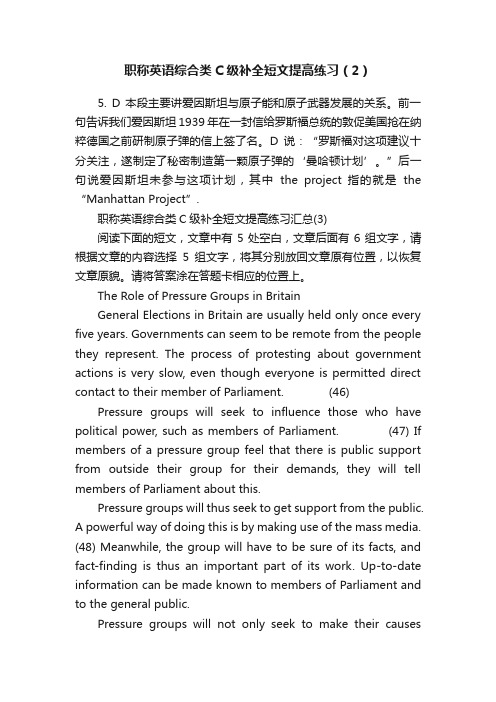
职称英语综合类C级补全短文提高练习(2)5. D 本段主要讲爱因斯坦与原子能和原子武器发展的关系。
前一句告诉我们爱因斯坦1939年在一封信给罗斯福总统的敦促美国抢在纳粹德国之前研制原子弹的信上签了名。
D说:“罗斯福对这项建议十分关注,遂制定了秘密制造第一颗原子弹的‘曼哈顿计划’。
”后一句说爱因斯坦未参与这项计划,其中the project 指的就是the “Manhattan Project”.职称英语综合类C级补全短文提高练习汇总(3)阅读下面的短文,文章中有5处空白,文章后面有6组文字,请根据文章的内容选择5组文字,将其分别放回文章原有位置,以恢复文章原貌。
请将答案涂在答题卡相应的位置上。
The Role of Pressure Groups in BritainGeneral Elections in Britain are usually held only once every five years. Governments can seem to be remote from the people they represent. The process of protesting about government actions is very slow, even though everyone is permitted direct contact to their member of Parliament. (46)Pressure groups will seek to influence those who have political power, such as members of Parliament. (47) If members of a pressure group feel that there is public support from outside their group for their demands, they will tell members of Parliament about this.Pressure groups will thus seek to get support from the public.A powerful way of doing this is by making use of the mass media.(48) Meanwhile, the group will have to be sure of its facts, and fact-finding is thus an important part of its work. Up-to-date information can be made known to members of Parliament and to the general public.Pressure groups will not only seek to make their causesknown to government, but also try to inform and influence the public. (49)Pressure groups may support political parties, but will lay stress only on some of their policies. For instance, the Monday Club will support the more right-wing policies of the Conservative Party. (50)A A good example of this sort of activity is provided by the educational work of "Shelter", which fights for better housing for poor peopleB They will want to tell them what policy their interest demandsC For all these reasons there is something of a vacuum between government and the governed, which pressure groups help to fD There can also be public meetings, demonstrations, etcE Governments always stay close to the people.F However, a pressure group is not a political party, because it does not seek complete or continuous political power.答案:46. C 47. B 48. D 49. A 50. F职称英语综合类C级补全短文提高练习汇总(4)下面是职称英语考试综合类补全短文专项训练,育路教育网特别为您搜集整理,内容如下:American DreamsThere is a common response to America among foreign writers: the US is a land of extremes where the best of things are just as easily found as the worst. This is a cliché(陈词滥调)。
职称英语综合类C级补全短文练习题
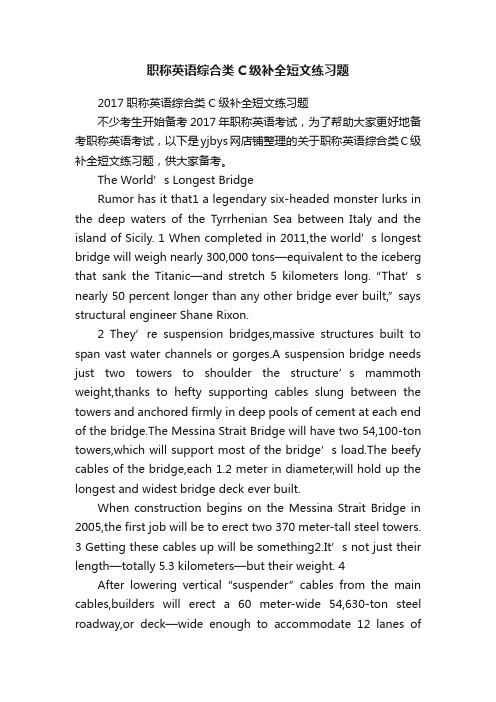
职称英语综合类C级补全短文练习题2017职称英语综合类C级补全短文练习题不少考生开始备考2017年职称英语考试,为了帮助大家更好地备考职称英语考试,以下是yjbys网店铺整理的关于职称英语综合类C级补全短文练习题,供大家备考。
The World’s Longest BridgeRumor has it that1 a legendary six-headed monster lurks in the deep waters of the Tyrrhenian Sea between Italy and the island of Sicily. 1 When completed in 2011,the world’s longest bridge will weigh nearly 300,000 tons—equivalent to the iceberg that sank the Titanic—and stretch 5 kilometers long.“That’s nearly 50 percent longer than any other bridge ever built,”says structural engineer Shane Rixon.2 They’re suspension bridges,massive structures built to span vast water channels or gorges.A suspension bridge needs just two towers to shoulder the s tructure’s mammoth weight,thanks to hefty supporting cables slung between the towers and anchored firmly in deep pools of cement at each end of the bridge.The Messina Strait Bridge will have two 54,100-ton towers,which will support most of the bridge’s loa d.The beefy cables of the bridge,each 1.2 meter in diameter,will hold up the longest and widest bridge deck ever built.When construction begins on the Messina Strait Bridge in 2005,the first job will be to erect two 370 meter-tall steel towers.3 Getting these cables up will be something2.It’s not just their length—totally 5.3 kilometers—but their weight. 4After lowering vertical“suspender”cables from the main cables,builders will erect a 60 meter-wide 54,630-ton steel roadway,or deck—wide enough to accommodate 12 lanes oftraffic.The deck’s weight will pull down on the cables with a force of 70,500 tons.In return,the cables yank up against their firmly rooted anchors with a force of 139,000 tons—equivalent to he weight of about 100,000 cars.Those anchors are essential. ____(5)_____词汇:legendary adj.传说中的 monster n.怪物,妖怪lurk v.潜伏 Sicily 西西里岛(意大利南部)Tyrrhenian Sea第勒尼安海 Messina Strait墨西拿海峡gorge n.峡谷 mammoth v.巨大的hefty adj.高强度的 sling v.用悬带吊挂(slung,slung)beefy adj.结实的. yank v.拽注释:1.Rumor has it that:传说中说……Rumor has it that这是一种固定结构。
- 1、下载文档前请自行甄别文档内容的完整性,平台不提供额外的编辑、内容补充、找答案等附加服务。
- 2、"仅部分预览"的文档,不可在线预览部分如存在完整性等问题,可反馈申请退款(可完整预览的文档不适用该条件!)。
- 3、如文档侵犯您的权益,请联系客服反馈,我们会尽快为您处理(人工客服工作时间:9:00-18:30)。
2016职称英语教材-卫生类C级完形填空及参考译文1第一篇Better Control of TB Seen If a Faster Cure Is FoundThe World Health Organization1 estimates that about one-third of all people are infected with bacteria that cause tuberculosis . Most times, the infection remains inactive. But each year about eight million people develop active cases of TB, usually in their lungs. Two million people die of it. The disease has increased with the spread of AIDS and drug-resistant forms of tuberculosis. Current treatments take at least six months. People have to take a combination of several antibiotic drugs daily. But many people stop as soon as they feel better. Doing that can lead to an infection that resists treatment. Public health experts agree that a faster-acting cure for tuberculosis would be more effective. Now a study estimates just how effective it might be. A professor of international health at Harvard University2 led the study. Joshua Salomon says a shorter treatment program would likely mean not just more patients cured. It would also mean fewer infectious patients who can pass on their infection to others.The researchers developed a mathematical model to examine the effects of a two-month treatment plan. They tested the model with current TB conditions in Southeast Asia. The scientists found that a two-month treatment could prevent about twenty percent of new cases. And it might prevent about twenty-five percent of TB deaths. The model shows that these reductions would take place between two thousand twelve and two thousand thirty. That is, if a faster cure is developed and in wide use by two thousand twelve.The World Health Organization reductions the DOTS3 program in nineteen ninety. DOTS is Directly Observed Treatment, Short-course. Health workers watch tuberculosis patients take their daily pills to make sure they continue treatment.Earlier this year, an international partnership of organizations announced a plan to expand the DOTS program. The ten-year plan also aims to finance research into new TB drugs. The four most common drugs used now are more than forty years old. The Global Alliance for TB Drug Development4 says its long-term goal is a treatment that could work in as few as ten doses.1.找到速效治疗剂可以更好控制结核病世界卫生组织估计全球有大约三分之一的人感染了导致结核病的病菌。
大多数时候,这种感染是不活跃的。
但是每年大约有八百万结核病病例,通常是在肺部。
两百万人因此丧命。
结核病发病率由于艾滋病的传播和抗药型结核病的出现而增加。
目前的治疗至少需要六个月。
患病者不得不每日服用多种抗生素药品。
许多人在稍感舒适后就停止使用药品,这么做可能导致抗药性感染。
公共卫生专家一致认为针对结核病的速效治疗剂将会更加有效果。
现在有一项研究评估这种速效治疗剂究竟效力有多大。
这项研究由美国哈佛大学国际卫生方面的教授率领。
Joshua Salomon说,疗程较短的治疗计划可能不仅仅意味着更多病人被治好,也意味着将感染传给别人的病人会更少。
研究者们设计了一个数学模型来检测两个月治疗计划的效果。
他们以东南亚目前的结核病情况来检验这个模型。
科学家们发现两个月的治疗可以防止大约20%的新病例,也可能防止大约5%因结核病引起的死亡。
这个模型表明,如果速效治疗剂可以在2012年前研发出来并大规模使用的话,减少结核病例在2012年到2030年间就可以实现。
世界卫生组织在1990年制定了DOTS计划,DOTS意指短期直接观察治疗。
卫生工作者监督结核病人每天服药,以确信他们继续治疗。
今年年初,一个国际组织同盟宣布了一项扩大DOTS的计划。
这个十年计划也旨在资助新结核药品的研究。
现在四种最常用的药品也有四十多年的历史了。
全球结核病药物开发联盟宣称它的长期目标是找到一种治疗方法,可以通过十次剂量就效果。
第二篇:A Biological ClockEvery living thing has what scientists call a biological clock that controls behavior. The biological clock tells____1____when to form flowers and when the flowers should open. It tells_____2___when to leave the protective cocoons and fly away, and it tells animals and human beings when to eat, sleep and wake.Events outside the plant and animal____3____the actions of some biological clocks. Scientists recently found, for example, that a tiny animal changes the color of its fur____4____the number of hours of daylight. In the short____5____of winter, its fur becomes white. The fur becomes gray brown in color in the longer hours of daylight in summer.Inner signals control other biological clocks. German scientists found that some kind of internal clock seems to order birds to begin their long migration____6____twice each year. Birds____7____flying become restless when it is time for the trip,_____8___they become calm again when the time of the flight has ended.Scientists say they are beginning to learn which____9____of the brain contain biological clocks. An American researcher, Martin Moorhead, said a small group of cells near the front of the brain____10____to control the timing of some of our actions. These____11____tell a person when to____12____, when to sleep and when to seek food. Scientists say there probably are other biological clock cells that control other body activities.Dr. Moorhead is studying____13____our biological clocks affect the way we do our work. For example, most of us have great difficulty if we must often change to different work hours.____14____can take many days for a human body to accept the major change in work hours. Dr. Moorhead said industrial officials should have a better understanding of biological clocks and how they affect workers. He said____15____understanding could cut sickness and accidents at work and would help increase a factory’s production.词汇:biological /baɪə(ʊ)'lɒdʒɪk(ə)l/ adj.生物(学)的insect /'ɪnsekt/ n.昆虫cocoon /kə'kuːn/ n.防护卵袋,茧fur /fɜː/ n.软毛migration /maɪ'greɪʃ(ə)n/ n.迁徙restless /'res(t)lɪs/ adj.焦躁不安的contain /kən'teɪn/ v.含有cell /sel/ n.细胞注释:1. 本句中谓语动词tells的宾语由两部分组成。
